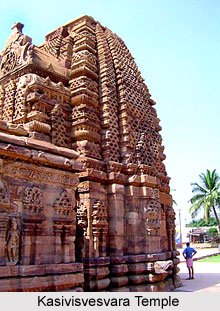 Kasivisvesvara Temple is one of the most ornate temples in the Indian state of Karnataka. According to the inscription of 1087A.D. the temple had a simple construction and decoration was added later on. Hoyslala King Veera Ballala II annexed Lakkundi from the Senas of Devagiri and made it the capital of his kingdom around 1193 CE. There is a possibility that the temple may have been renovated during his rule.
Kasivisvesvara Temple is one of the most ornate temples in the Indian state of Karnataka. According to the inscription of 1087A.D. the temple had a simple construction and decoration was added later on. Hoyslala King Veera Ballala II annexed Lakkundi from the Senas of Devagiri and made it the capital of his kingdom around 1193 CE. There is a possibility that the temple may have been renovated during his rule.
Architecture of Kasivisvesvara Temple
This temple has two shrines one facing east and the other one faces the west. The one facing the east is dedicated to Kasivisvesvara or Lord Shiva whose symbol, a linga, is three feet tall that is in the sanctum. The one facing the main shrine is dedicated to Lord Surya that is known as Suryanarayana. This shrine faces west. This temple also epitomizes the shift in Chalukyan artistic achievements. Mouldings, arches and decorations on door jambs and lintels have been done with special attention.
The architecture has been inspired by the architecture of northern India. Several decorative miniature towers of the Sekhari and Bhumija types, supported on plasters are features of this temple. Sculptural depictions of deities were discreet and the pillar bodies appeared as wall decorations are the other features of this temple.
Sculpture of Kasivisvesvara Temple
The southern doorway has four inner bands of scrolls that run up the sides as well around the lower part too. Beside these bands on either side in the centre there are tall columns that support lower cornice. There are four more bands of decorative mouldings beyond these columns. On the doorway beam there is an image of Gaja Lakshmi with an elephant on either side. Above the lower cornice, the structure consists of small figures standing under cusped arches.
The eastern doorway decoration is known for its filigree work. The dedicatory block on the doorway has an image of Gaja-Lakshmi and her elephants. Above the cornice there is an image showing a procession of men and animals. These images also include horsemen and musicians. Above these there are the images of Lord Brahma, Lord Vishnu and Lord Shiva.
The outer wall ornamentation consists of prominent central niches above which there is a miniature sikhara which is north Indian in style and cuts through the main cornice. The decorative arch is a noticeable ornamental feature of the superstructure. In the temple hall, the pillars, their capital, and brackets figures that include little lions, kirthimukhas and scrolls reveal the skilful workmanship. The artisans used finely grained stone in order to produce polished pillars whose shafts have a rounded appearance that is the result of using a lathe.











